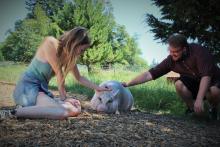During summer quarter’s A-term this year, seven students participated in Animals, Ethics and Food: Doing Multispecies Ethnography, a CHID 250 course that brought together students from majors as different as CHID, Anthropology, Biology and Computer Science. The course was designed around exploring multispecies ethnography as a method through the lens of learning about the role of animals in the food system, and students completed their own multispecies ethnographies at Pigs Peace Sanctuary. Pigs Peace is a nonprofit organization in Stanwood, WA dedicated to the rescue and rehabilitation of approximately 190 pigs and the education of the public about the plight of farmed animals in the United States.
We spent one day each week at the sanctuary where they conducted fieldwork on the geography of the sanctuary and the animals who lived there. On the first day, each student was paired with an individual pig. They spent most of their field work time each week sitting with or wandering the sanctuary with that individual pig, getting to know them and trying to understand what life was for these pigs at Pigs Peace. Judy Woods, the founder and director of the sanctuary, gave generously of her time and knowledge and we all learned so much from her expertise as a true revolutionary in pig care.
Multispecies ethnography is an emerging methodological trend and we used our time in class to explore theoretical and practical questions about this work: How do we come to know another animal (their likes/dislikes, their navigation of the world, and the intimate dimensions of their most inner lives)? What difficulties are there in interpreting an Other’s perspective, especially when that Other is a member of another species? What limitations and/or advantages do we see in our ability to tell this pig’s story and how do we understand our positionality and specifically our privilege as humans in relation to other species? How do we understand the sanctuary as a place in the world – in other words, how is this place designed for pigs (and not humans) and what does this mean for their care?
During our time in the classroom on campus, we interrogated these questions together and struggled through thinking about our ethical and political responsibilities to farmed animal species. We read books, watched documentaries, spoke from our own experiences, and shared delicious vegan (and gluten free!) food together. The students’ final ethnographies were brilliant – amazingly thoughtful, open-hearted, critically engaged with the ideas we had explored all quarter, and they showed a profound connection to the experience of coming face-to-face with actual animals and learning from them. Each student wrote about the uniqueness of the individual pig they worked with, and there was a great moment during their final presentations when we realized that every pig was unique – a realization that may seem simple, but is often overlooked and denied when we think about farmed animals.

On the last day of class, we volunteered for Judy and the pigs at the sanctuary – shoveling wood chips, weeding, and pruning overgrown trees. It was pouring rain that day, but we had so much fun contributing some tiny bit of labor in gratitude for what we had learned and experienced there this summer. At the end of the day, we gathered in the education center and shared a meal with Judy and an immensely dedicated volunteer, Michelle, and we gave Judy copies of the ethnographies. At the end of each sanctuary day, we would feed the pigs 100 pounds of carrots as a treat. Judy would ring the “treat bell” and more than a hundred big pigs and small pigs would come galloping across the field. It is a sight that doesn’t soon leave your memory – pigs running toward you, ears flapping, bellies swinging back and forth, and the sounds of the pigs as they ate, their squeals of disagreement over whose carrot was whose and the satisfied munching of carrots and loud licking of the concrete feeding platform.
Partnering with the sanctuary in this way – and working with the pigs in particular – offered a new and exciting way to theorize and understand the implications of embodied human-animal relations. Hopefully this is just the beginning of bringing this significant experiential dimension into classes on animals at UW. We were all so grateful to CHID for making the space where we could engage in this work and learn from and with other animals – it was a profound learning experience for all who participated.
